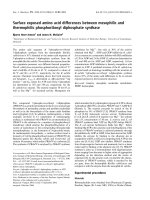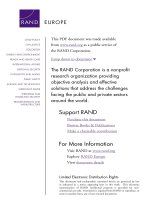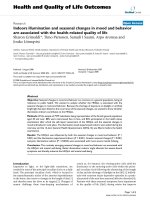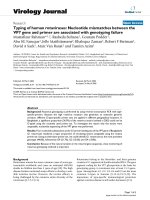DIFFERENCES BETWEEN HETEROSEXUAL AND LESBIAN WOMEN IN ACCEPTABILITY AND RISK PERCEPTIONS ASSOCIATED WITH SEXUAL PERMISSIVENESS
Bạn đang xem bản rút gọn của tài liệu. Xem và tải ngay bản đầy đủ của tài liệu tại đây (361.4 KB, 93 trang )
Sexual Permissiveness & Risk Perception
Differences between heterosexual and lesbian women in
acceptability and risk perceptions associated with sexual
permissiveness
In many countries, homosexuality is a crime with
varying degrees of severity of punishment. In Saudi Arabia and
Iran, it is punishable by death. In Jamaica, those convicted are
sentenced to 10 years hard labor. In Malaysia, a jail sentence
awaits. The United Nations General Assembly, which heard two
opposing statements on lesbian, gay, bisexual, transsexual, and
intersex (LGBTI) rights on December 18, 2008, shed some light on
prevalent global sentiment. It was argued that discrimination,
violence, criminal sanctions, and abuse based on sexual or gender
identity violate LGBTI human rights. Navanethem Pillay, the
United Nations High Commissioner for human rights, commented that
laws against homosexuality “are increasingly becoming recognized
as anachronistic and as inconsistent both with international law
and with traditional values of dignity, inclusion and respect for
all” (Macfarquhar, 2008). The response to LGBTI rights among
member countries, however, was mixed. Sixty-six nations supported
such rights, 57 were against them, and 69 abstained. However, on
closer examination, the picture for Asia was more consistent. In
Asia, only Armenia, Japan, Nepal, and Timor-Leste supported LGBTI
rights. Indonesia, Malaysia, and Brunei opposed. The rest of the
South East Asian countries, including Singapore, abstained.
Therefore, by their abstinence, the majority of countries in Asia
showed a sense of ambivalence towards LGBTI rights.
The stance taken by Singapore in the recent UN General
Assembly is reflective of its population’s mixed response to the
gay and lesbian community. An unsuccessful attempt to
1
Sexual Permissiveness & Risk Perception
decriminalize sex acts between two men (section 377A in the penal
code) in 2007 brought this issue to the forefront. Under section
377A, it is stated, “penetration is sufficient to constitute the
carnal intercourse necessary to the offence described in this
section”. Opponents of the repeal of section 377A had spoken
against the decriminalization of sex between men. In response to
the fierce debate on both sides, the government opted to remain
with the status quo (Ramesh, 2007, September 22). Prime Minister
Lee Hsien Loong said, “the tone of society, the public, and
society as a whole, should be really set by the heterosexuals and
that’s the way many Singaporeans feel… what people do in private
is their own business; in public, certain norms apply” (Ramesh,
2007, September 22). Therefore, sex acts between males continue
to be criminalized, even though there remain strong feelings
among both camps.
Unlike their gay counterparts, lesbian women were left out
of the penal code and newspaper articles related to the acquired
immune deficiency syndrome (AIDS). This did not mean, however,
that they were spared from being portrayed in a negative light.
Some religious groups, for instance, warned that living a lesbian
lifestyle would end in misery because of greater promiscuity in
the lesbian community (e.g., Harley, 2003). In a brochure
entitled “Straight Talk”, given out to secondary school students
in Singapore, significant numbers of lesbian women were said to
exchange sex for money and drugs (Harley, 2003). It was also
written that “lesbian relationships are equally unhealthy and
just as life-threatening as gay male relationships”. The sexual
health consequences of lesbian activities were emphasized.
2
Sexual Permissiveness & Risk Perception
Promiscuity has been defined as irresponsible sexuality,
such as having unprotected sex with multiple sexual partners,
with adverse health consequences such as sexually transmitted
infections (STIs) and unwanted pregnancy (Gershman, 1997; Markey
& Markey, 2007; Widom & Kuhms, 1996). Sexual permissiveness
appears to cover any sexual behavior that falls outside of a
committed marriage. Examples of sexual permissiveness are onenight stands and having threesomes. Certain behaviors are more
ambiguous however. For instance, some people perceive premarital
sex within committed dating partners as acceptable, but there are
others who view the same as sexual permissiveness. Therefore,
promiscuity appears to be broadly captured by the concept of
sexual permissiveness coupled with irresponsibility and adverse
health consequences. The chief emphasis of many current safe sex
campaigns is on responsible sex. While safe sex campaigners
advocate being faithful to one sexual partner, their work among
female sex workers stresses protective measures so that adverse
consequences can be avoided. Thus, while promiscuity includes
sexual permissiveness, sexual permissiveness can be meaningfully
distinguished from promiscuity in that the latter implies both
irresponsibility and adverse health consequences, while sexual
permissiveness can exist with responsibility (i.e., having
multiple partners but always practicing safe sex) that eliminates
or at least minimizes adverse health consequences.
Are lesbian women sexually permissive? While there is a
paucity of research studies on sexual behaviors and attitudes of
lesbian women in Asia, research conducted outside of Asian
countries suggests that lesbian women can be sexually permissive.
In Morrow and Allsworth’s (2000) survey study on sexual risks in
3
Sexual Permissiveness & Risk Perception
lesbian women and bisexual women, 13% of their lesbian sample
(total lesbian sample size was 436) were then sexually inactive,
70% had a single sexual partner, and 17% had multiple partners.
Of those who had been sexually active in the previous year, 30%
of their lesbian participants ever had multiple female sexual
partners. In Montcalm and Myers’ (2000) study, lesbian
participants reported between none to 110 sexual partners in the
previous year, with 72% having had only one sexual partner.
Therefore, while the majority of lesbian women in these two
samples prefer monogamy, approximately a quarter of them do
engage in sex with multiple partners.
Perceived risk influences the use of safe sex methods.
Lesbian women who had a history of STIs, had a friend with human
immunodeficiency virus (HIV), or perceived greater risk for the
self were more likely to be concerned about STIs and practice
safe sex (Diamant, Lever & Schuster, 2000; Montcalm & Myer,
2000). However, it is likely that Singaporean lesbian women think
that they are impervious to the effects of STIs. Newspapers
frequently allude to HIV and AIDS as a gay man’s illness (e.g.,
Wong, 2008). Reporting on infected heterosexuals tends to be
male-centric, such as a focus on males who participate in the
Batam (Indonesia) sex trade. In such instances, married women are
portrayed as victims, being infected as a result of and without
knowledge of their husbands’ extramarital sexual stints. HIV and
AIDS are not typically associated with lesbian women in local
news reporting, possibly contributing to the perception that
lesbian women are invulnerable. This perception, where many
lesbian women see themselves as “safe” from STIs, has been termed
“lesbian immunity” (Montcalm & Myer, 2000), which is a perception
4
Sexual Permissiveness & Risk Perception
of low or no sexual risk when the sexual partner is a fellow
female. Studies conducted in other countries showed that many
health practitioners subscribed to this misconception as well
(Dworkin, 2005).
Local HIV and AIDS infection statistics may also contribute
to this perception of lesbian immunity. From Singapore’s Ministry
of Health’s statistics on HIV infections or AIDS (Ministry of
Health, 2008), the trend, from 1985 to 2007, showed that infected
females were increasingly outnumbered by infected males. The
number of women who were infected made up approximately 10% of
the number of infected men over the last three years. In the year
2007, 31 women were affected as compared to 392 men. In the year
2006, 32 women were affected as compared to 325 men. In 2005, the
figures were 30 and 287 for females and males, respectively.
Between 2005 and 2007, the odds of married heterosexual women
being infected were more than twice that of single women (the
statistics for single women do not distinguish between
heterosexual and lesbian women). These small numbers of female
infections may lead Singaporean lesbian women to perceive
themselves as not at risk, since they are female and
predominantly unmarried (as same-sex marriage is not allowed in
Singapore).
Because of this general perception of invulnerability,
lesbian women who are aware of safer sexual behaviors may
therefore not utilize, even with multiple partners, protective
measures (such as dental dams, which are rectangular sheets of
latex placed over the genital region during oral stimulation of
the genital, or rubber gloves, which are used during finger
penetration of the vagina) during risky sexual activities
5
Sexual Permissiveness & Risk Perception
(Fishman & Anderson, 2003; Richardson, 2000). Thus, the
perception of lesbian immunity may actually be a basis for
lesbian women not only being more permissive (having multiple
partners) but also being irresponsibly permissive (having unsafe
sex with multiple partners).
Contrary to this perception of immunity, the wide variety of
sexual activities that lesbian women engage in may expose them to
STIs. In Montcalm and Myer’s (2000) sample of 248 lesbian
participants, the majority practiced receiving digital-vaginal
sex (where a partner’s finger is inserted into one’s vagina)
(84.3%), giving digital-vaginal sex (where one inserts a finger
into a partner’s vagina) (87.1%), receiving oral-vaginal sex
(where a partner orally stimulates one’s vagina) (79.0%) and
giving oral-vaginal sex (where one orally stimulates a partner’s
vagina) (81.5%). Sharing of sex toys such as dildos (33.9%),
receiving digital-anal sex (where a partner’s finger is inserted
into one’s anus) (23.4%), giving digital-anal sex (where one
inserts a finger into a partner’s anus) (24.2%) and fisting
(inserting a hand or all fingers into the vagina or anus) (less
than 10% each for vaginal and anal fisting) were much less
popular. About one-quarter of the women had sex involving genital
contact during their partners’ menstruation. A similar
preponderance of sexual activities was found in Morrow and
Allsworth’s (2000) sample of 504 lesbian women, with
approximately 90% of participants practicing oral-vaginal and
digital-vaginal sex. Although HIV infections and AIDS are much
lower for unmarried females (which would include most lesbian
women), exposure to mucous membranes, vaginal secretions, and
menstrual blood increases the risk of acquiring STIs such as
6
Sexual Permissiveness & Risk Perception
herpes and chlamydia (Fishman & Anderson, 2003; Marrazzo, Coffey,
& Bingham, 2005). Some lesbian women acquire female bisexual
partners who have had multiple male sexual partners before, thus
increasing their risk of STIs (Dworkin, 2005) such as
trichomoniasis and anogenital warts which can affect women who
never had sex with men (Morrow & Allsworth, 2000). Once infected,
complications are greater in women as compared to men, and women
face a wider variety of problems, such as infertility and chronic
pelvic pain (Diamant, Lever, & Schuster, 2000). Thus, even if the
risk for women is indeed lower, it does not mean there is no risk
at all. As mentioned earlier, sexual activities that involve
infected vaginal fluid and menstrual blood coming into contact
with mucosal membranes, open sores, or cuts increase one’s
susceptibility to STIs. Therefore, lesbian immunity is really an
illusion; lesbian women do not possess immunity to STIs. If
lesbian women are indeed more sexually permissive and
irresponsibly so because of the perception of immunity even
though they really are not immune, this can have important
implications for the sexual health of the lesbian community. The
main objective of this thesis was therefore to examine
perceptions associated with sexual permissiveness, focusing on
acceptability (how acceptable) and risk (how risky) ratings
associated with such permissiveness among lesbian women, and to
contrast these acceptability and risk perceptions against those
of heterosexual women.
In many studies on lesbian women, lesbian women were
recruited on the basis of their self-identification as lesbian
women (e.g., Montcalm & Myer, 2000; Morrow & Allsworth, 2000).
This self-identification approach can be problematic because
7
Sexual Permissiveness & Risk Perception
self-identified lesbian women may not include only lesbian women
but also those who are bisexual as well. According to Diamond
(2005b), women with attractions to both genders are more likely
to change their sexual identity over time because, after
acknowledging same-sex attractions, they have the additional step
of weighing how strongly they lean towards each gender. Thus,
some self-identified lesbian women may actually be bisexuals in
the making. Indeed, in Rust’s (1993) retrospective study, 75% of
bisexual respondents once identified themselves as lesbian.
Alternatively, there may be bisexual respondents who identify
themselves as lesbian women because they have a predominant
interest in women even though they are attracted (to different
extents) to both genders (Diamond, 2005b). Many self-identified
lesbian women have also had sex with men (Champion, Wilford,
Shain, & Piper, 2005). Thus, self-identification as a lesbian
women appears to function more as a tool for making sense of
current sexual attractions (Weinberg, Williams, & Proyer, 1994).
Additionally, some women may maintain a lesbian identity for
reasons irrelevant to their sexuality. For instance, one woman
identified as herself as a lesbian simply because of a dislike
for the heterosexual culture (Diamond, 2005b).
To enhance knowledge and understanding, it is meaningful to
make distinctions between bisexual women and lesbian women
(Gangestad, Bailey, & Martin, 2000). Diamond’s (2005a) study on
subgroups of sexual minority women involving “stable lesbians”
(consistently identifying as lesbian), “fluid lesbians” (changing
between sexual identities), and “stable nonlesbians” (never
adopted lesbian sexual identity, bisexual or unlabeled) is a step
forward in this regard. Such a distinction is useful in that it
8
Sexual Permissiveness & Risk Perception
was found that “stable lesbians” had the smallest fluctuations in
their emotional and physical attraction to the same sex (Diamond,
2005a). In this light, studies that recruit lesbian women may not
really have only lesbian women in their samples, which would
raise questions regarding the generalizability of their results
to lesbian women. One solution to this problem, which would also
enhance generalizability to lesbian women, is to flesh out the
term “lesbian” in terms of specific criteria, so that potential
participants are not left to their own interpretations of who a
lesbian is. This therefore was the approach adopted in this
thesis. Specifically, lesbian women were defined as women who
experienced emotional and physical attractions towards members of
the same sex only. Such an approach reduced the lesbian sample to
only a subgroup of WSW (women who have sex with women) and helped
to sift out bisexual women as well as those who identified
themselves as lesbian for reasons irrelevant to their sexuality.
In specifying the criteria associated with the term “lesbian”
during recruitment, potential participants were therefore
provided with objective markers to determine their eligibility
for participation.
In many studies on lesbian women, heterosexual women were
not included as a comparison group. While this may be seen as an
acknowledgement of or statement of intent that lesbian women are
a group worthy of study in and of themselves, there may be
inadvertent knowledge gaps that are created regarding what
actually differentiates heterosexual women and lesbian women.
From a pragmatic point of view, when comments are made about
lesbian women’s sexuality (such as those by religious groups),
such comments typically pitch the perceived deviant (lesbian
9
Sexual Permissiveness & Risk Perception
women) against the socially acceptable (heterosexual women).
Although this may be perceived as biased or prejudiced,
heterosexual women do offer a familiar reference point for
understanding lesbian women. By asking the same questions of both
groups, it is then possible to accurately quantify both
differences and similarities between the two groups, and in so
doing actually provide for a better understanding of lesbian
women. This thesis therefore examined perceptions associated with
sexual permissiveness in local lesbian women, with local
heterosexual women as a comparison group.
Sexual permissiveness is often conceptualized in terms of
actual behavior (the number of partners one has). However, such
an approach can be severely limiting in recruiting participants,
especially in an Asian context where people tend to be more
conservative, such that fewer people may actually have multiple
partners or are sufficiently bold to be forthcoming about the
number of partners they have. To circumvent this, this thesis
assessed sexual permissiveness from an attitudinal (how
acceptable) perspective and a perceptual (how risky) perspective.
Cross-cultural studies have been done examining sexual attitudes
of French and American participants, where the French were found
to be more permissive (LeGall, Mullet, & Riviere-Shafighi, 2002).
There were also gender comparative studies that found women to be
less sexually permissive (Hendrick & Hendrick, 1987). Risk
perceptions, as examined in this study, pertain to the level of
perceived risk associated with sexual permissiveness. It should
be noted that perceptions of risk need not correspond with actual
risk levels. It is perceived risk, however, that typically
influences behavior rather than actual risk levels. As noted
10
Sexual Permissiveness & Risk Perception
previously, lesbian women who were conscious of sexual risks were
more likely to utilize safe sex methods. Therefore, risk
perceptions, not actual levels of risk, were of interest in this
thesis.
Overview of the Current Research
This thesis covered 2 studies. The first study examined
terms relevant to sexual permissiveness. Examining sexual
permissiveness encompassed understanding perceptions of
relationships, sex, and virginity. Focus group discussions with
heterosexual and lesbian women were employed towards this end.
The second study sought to tease out the nuances in acceptability
and risk perceptions when different sexual orientations
(specifically heterosexual or lesbian), genders and sex types
(such as penile-vaginal intercourse or kissing) come into play.
This attempt took the form of a survey questionnaire. The terms
in the questionnaire were clarified using the results of study 1,
so as to maximize similar interpretation of questionnaire items.
Study 1
Before examining differences between lesbian and
heterosexual women in how they perceived acceptability and risk
in sexual permissiveness, it is important first of all to
determine whether heterosexual and lesbian women perceive
relationships, sex, and virginity similarly. This includes
definitions and purposes, such as what it means to be and the
purposes of being in a relationship, having sex, as well as the
importance of virginity (virginity was included because previous
studies had linked it to sexual permissiveness (Pitts & Rahman,
2001). Such a first step is necessary to ensure that when
comparisons are subsequently made concerning perceptions, there
11
Sexual Permissiveness & Risk Perception
can be confidence that these perceptions apply to concepts and
terms that are either interpreted similarly by both groups of
women or are known to have different interpretations for the two
groups of women.
A key question for the two groups of women is the question
of what constitutes sex. Answers here have the potential of
revealing common sexual activities that both groups of women are
familiar with. In doing so, the accompanying perceptions of
acceptability and risk of these common sexual activities can then
be assessed with confidence. Eliciting responses on the purposes
of being in a relationship and having sex might also shed light
on differences between lesbian and heterosexual women that could
contribute to the negative stereotype of promiscuity. Knowing the
purposes can also highlight the boundaries and expectations of
being in a relationship for these two groups of women.
Available literature suggests that there are possible
differences between heterosexual and lesbian women in how they
view relationships, sex, and virginity. Heterosexual and lesbian
women, for instance, are likely to differ in their
characteristics of what a romantic relationship is. There is
evidence that heterosexuals equate monogamy with commitment and
non-monogamy with infidelity (Smart, 2006). On the other hand,
those with same-sex attractions recognize sexual non-exclusivity,
which is common among gay-men coupling (Smart, 2006). Therefore,
lesbian women are likely to possess a broader definition of
“relationship”, recognizing non-monogamous relationships as
valid, as compared to their heterosexual counterparts. Given such
a discrepancy, lesbian women may consider other forms of
relationships when responding to the term “relationship”. This is
12
Sexual Permissiveness & Risk Perception
problematic because infidelity is a violation of boundary
agreements set between relationship partners. For heterosexuals,
these markers are likely to be fixed (non-monogamy equates
infidelity). For lesbian women, these markers are likely to be
negotiable (non-monogamy may not be a sign of infidelity,
depending on prior agreements). Promiscuity, especially that
leading to truncated relationships, carries connotation of
violation of boundaries. If such a difference in how
relationships are viewed surfaced among local lesbian and
heterosexual women, there would be a need to take this difference
into account before any meaningful comparison could be made in
terms of how acceptability of and risks associated with sexual
permissiveness are perceived.
Secondly, heterosexual and lesbian women may define sex and
virginity differently according to different predominant sexual
activities, different gender of partner, and presence of orgasm.
This has implications for use of the term “sex” for each group of
women. Lesbian women have been reported to engage in oral-vaginal
sex, oral-anal sex, digital-vaginal sex, digital-anal sex and
tribadism (rubbing of one’s genitals against partner’s body part)
(Fishman & Anderson, 2003; Morrow & Allsworth, 2000). Penilevaginal intercourse is naturally absent from lesbian women’s
repertoire. For heterosexual women, however, penile-vaginal
intercourse is possibly the gist of “having sex”. In Pitts and
Rahman’s (2001) study, an overwhelming percentage of female
participants rated penile-vaginal intercourse as sex, compared to
kissing (less than 3%) or oral (less than 35%) or manual (less
than 20%) genital stimulation. Trotter and Alderson (2007) found
similar results, with their female participants most in agreement
13
Sexual Permissiveness & Risk Perception
that penile-vaginal intercourse is sex (more than 87%), compared
to deep kissing (less than 4%) or oral (less than 49%) or manual
(less than 28%) simulation.
Some studies suggest that definitions of sex and virginity
loss are defined according to one’s sexual experiences (Bersamin,
Fisher, Walker, Hill, & Grube, 2007). For example, female and
male heterosexuals were likely to define sex as penile-vaginal
intercourse (Trotter & Alderson, 2007). However, other studies
found no relationship between sexual experience and definitions
of sex. Bersamin et al. (2007), for instance, found among their
predominantly heterosexual participants that it was other factors
such as gender of partner, length of dating, and presence of
orgasm that affected definitions of sex. Specifically, their
participants (a) defined a sexual partner as being of an
opposite-sex partner, (b) were also more likely to consider a
larger number of activities as sex if they were in a dating
relationship with the partner for three months, compared to a
partner on a single date, (c) were more likely to consider as sex
oral sex with orgasm than oral sex without orgasm. Interestingly,
however, orgasm was not a criterion for sex when it came to
penile-vaginal or penile-anal intercourse. Participants also
appeared to have different yardsticks for judgment for oppositesex and same-sex partners. For example, they were more likely to
consider oral and manual genital stimulation as sex if the
partner was of the same-sex. Thus, although sexual experience did
not relate to definitions of sex here, it appeared that gender of
partner was nonetheless an important consideration, as is the
type of sexual activity being considered. It should be noted that
for these two studies, the number of lesbian participants were
14
Sexual Permissiveness & Risk Perception
not sufficiently large (less than 3% in Pitts & Rahman’s (2001)
sample and less than 2% in Trotter & Alderson’s (2007) sample)
to allow for firm conclusions, so that it remains unclear if
lesbian and heterosexual women do differ in how they define sex
and virginity.
The relationship between sex and virginity is also ambiguous
(Bersamin et al., 2007). Chambers (2007) showed from her sample
of female and male heterosexual college students from the
University of Georgia that perceptions towards what constitutes
sex and virginity loss differed across the participants. For
example, 41.7% of self-identified virgins had engaged oral sex
and 39.1% of those who engaged in oral sex but not sexual
intercourse called themselves non-virgins. This meant that
participants who had oral sex only may or may not classify
themselves as virgins, indicating disparate definitions of
virginity. Participants often described virginity loss in the
context of penile-vaginal intercourse, although some also
consider other types of sex as long as genitals were involved
(Carpenter, 2001; Trotter & Alderson, 2007). Pitts and Rahman
(2001) found that female participants, as compared to male
participants, had a narrower definition of sex and made mention
of the notion of “technical virginity” (such that one engaging in
sexual activities other than penile-vaginal intercourse remains a
virgin). There is likely to be more pressure on young unmarried
women to retain their virginity. Non-virgin status might be
construed as indicating sexual promiscuity.
In sum, study 1 was done to examine and compare how lesbian
and heterosexual women viewed relationships, sex, and virginity.
Method
15
Sexual Permissiveness & Risk Perception
Participants
The participants consisted of 38 heterosexual and 38 lesbian
women. Participants were all English-speaking. There were no prerequisites set for participation regarding experience in
relationships and sex because views and opinions were the focus
of this study. Heterosexual women were acquired from the Research
Participants pool of the Department of Psychology at the National
University of Singapore.
Their ages ranged from 19 to 31 years (M = 21.40, SD =
2.30).
Lesbian women were recruited via posters, from local
online portals such as Sayoni.com, and online mailing lists such
as Signel yahoogroups. Their ages ranged from 21 to 34 years of
age (M = 25.40, SD = 3.70).
Lesbian participants were older than heterosexual
participants, t(74) = 5.67, p < .01. Participants were
predominantly Chinese, in the midst of acquiring or already
possessing a degree, and Christian/Catholic, Buddhist, or without
religion. Table 1 provides a summary of the demographics of the
participants in this study.
16
Sexual Permissiveness & Risk Perception
Table 1
Demographics Characteristics of Heterosexual (mean age = 21.40,
SD = 2.30) and Lesbian (mean age = 25.40, SD = 3.70) Participants
in Focus Group Discussions
Heterosexual
n
Lesbian
Percentage
n
Percentage
Race
Chinese
27
71.1
35
92.1
Indian
6
15.8
2
5.2
Malay
0
0
1
2.6
Others
5
13.2
0
0
O levels
0
0
1
2.6
Diploma/
0
0
6
15.8
37
97.4
29
76.3
1
2.6
2
5.2
7
18.4
15
39.5
10
26.3
5
13.2
Hindu
2
5.2
0
0
Islam
3
7.9
1
2.6
Others
1
2.6
2
5.2
Education Level
A levels
Undergrad
Postgraduate
Religion
Christian/
Catholic
Buddhist
17
Sexual Permissiveness & Risk Perception
No religion
15
39.5
15
39.5
18
Sexual Permissiveness & Risk Perception
Procedure
Focus group discussions were utilized to explore
participants’ opinions. This method has an added advantage over
one-to-one interviews because it allows group interaction and
participants to clarify each other’s opinions by asking
questions, making comments, and exchanging stories. This, in
turn, allows for the gathering of a potentially richer set of
data.
Permission was first sought from the NUS Institutional
Review Board (IRB) to conduct the study. Upon obtaining IRB
approval, recruitment for the focus group discussions was done.
Heterosexual women and lesbian women were recruited to
participate in separate focus group discussions. This was done to
take into account the ambivalence towards homosexuality in
Singapore and to minimize any sense of discomfort that may arise
from the different sexual orientations. Participants signed up
for sessions according to their availability.
The discussion itself was semi-structured. Specific
questions were asked in the same sequence in all sessions (see
Appendix A). However, wherever needed, additional questions were
asked for clarification or elaboration. The present author
facilitated all sessions. To prevent a minority from dominating a
group discussion, each participant was given a chance to speak
for each of the structured questions drawn up for discussion.
These sessions took place in various locations, including
tutorial rooms and quiet coffee places, according to the
convenience of participants. Each focus group discussion lasted
between 1 to 2 hours, with group sizes ranging from 4 to 10.
19
Sexual Permissiveness & Risk Perception
Seven sessions were conducted for heterosexual women and 6 were
conducted for lesbian women.
Before each session, participants were briefed on the
purpose of the study, after which they signed the consent form
(indicating voluntary participation) and then provided some
demographic data. Participants were encouraged to speak freely
and permission was obtained from participants for the session to
be audio-recorded. The sensitive nature of the study was
acknowledged and participants were told that their responses were
anonymous and their names would not be used in any report. After
each session, participants were thanked. Heterosexual
participants were given participation points for partial
fulfillment of their course requirements and lesbian participants
were given beverages as tokens of appreciation.
Results
Analytic Approach
The present author tape-recorded the focus group discussions
to retain exact content. Transcription of tapes to written text
was then done. That is, participants’ words were written
retaining its original form, including the use of colloquial
English, commonly known as “Singlish” in Singapore which is
characterized by non-words such as “la” and “lo”). These words
did not alter the meanings of the sentences, which were
decipherable through the English words they accompanied. For
transcription, ellipses (…) were used to indicate pauses.
In defining a meaningful unit for analysis, the smallest
text component is a full sentence and the biggest text component
is a paragraph (Laurenceau, Barrett, & Rovine, 2005; Sanderson,
Keiter, Miles, & Yopyk, 2007). A full sentence is defined as an
20
Sexual Permissiveness & Risk Perception
expression of one idea, contained within one or a few phrases. A
paragraph is defined as a number of sentences that are of the
same idea, such as elaboration of the same point in a continuous
flow. Questions were divided into distinct segments of the focus
group discussions (Schilling, 2006), namely, relationship, sex,
and virginity. Responses were thus separated according to
segments. Under each segment, responses were further separated
according to sub-questions, such as definition and purpose.
Categories from responses were then generated for each subquestion.
To generate categories, responses were first recoded to
reduce material and yet retain the crux of the contents. This
included deleting unnecessary words and transforming sentences to
short forms (Schilling, 2006). For example, a heterosexual
participant said this in response to expectations of a
relationship partner: “Someone you can completely be yourself
with, like with your bestest bestest best friend, there will be
some secrets you will not able to share, but you know you can
tell him everything and everything is going to be okay… might
fight or whatever… but at the end he will still be there for
you.” From this paragraph, the quality “best friend” was placed
as one category. Subsequently, responses that included “best
friend” defined as “someone you can share everything with” were
placed together.
Although numerical comparisons are at best tentative in
focus group analysis, such comparisons can point to substantive
issues. As an extreme example, if all of the lesbian focus groups
were to raise a particular point while none of the heterosexual
groups were to raise that same point, such a difference in
21
Sexual Permissiveness & Risk Perception
numbers may be indicative of important differences between
lesbian and heterosexual women. The use of numbers and numerical
comparisons was thus adopted, although caution was exercised not
to over-interpret the numerical differences.
Tapes were reviewed twice to check for consistency and to
minimize errors. A second heterosexual male Psychology student
(not from the Research Participant pool) also coded one
heterosexual and one lesbian group discussion to ensure the
reliability of coding. Inter-rater agreement was computed here as
total number of agreements minus total number of disagreements,
divided by total number of codes. The inter-rater agreement was
91.4%.
All names used in the following are pseudonyms to protect
participants’ confidentiality.
Defining Relationship
For all groups, participants were asked: “What is a
relationship?”
Participants in both lesbian and heterosexual groups defined
a relationship as romantic involvement with a partner. There
were, however, some differences between groups when discussing
relationship characteristics. Monogamy and commitment were
generated from all discussion groups, but 3 out of the 6 lesbian
groups generated “not necessary monogamous” as a characteristic
of a relationship whereas none of the heterosexual groups did.
The heterosexual and lesbian women groups also had slightly
different ideas about commitment. Heterosexual participants
explained commitment as monogamy. For example, Pat (a
heterosexual participant) stated,
“For me, being in a
relationship means… like ultimately commitment… you know… you
22
Sexual Permissiveness & Risk Perception
cannot be allowed to go on a date with some other girl… you know…
or be too close with some other girl… and for me as well.”
Lesbian participants, on the other hand, made a distinction
between commitment and monogamy. Commitment was defined as
working problems out together and making time for each other.
Nic, a lesbian participant, illustrated this as follows,
“Commitment is like… like… I know this is our relationship, we
are going to try it out… even if we have problems, we are going
to work it out between ourselves.”
The lesbian women also recognized open relationships (in
which partners are allowed to be emotionally and/or sexually
involved with more persons outside of the relationship) as valid
forms of romantic relationships but did not endorse such
relationships. Sharon (a lesbian participant) shared as follows,
“Like for me, as long as you and her are on the same page it’s
fine… it depends on the kind of partner you are bringing home…
how many times you have sex with that person… whether that person
is healthy, clean. Basically you have to lay all the cards on the
table… not just having random sex, orgies… I am more into… well,
I believe in open relationships… but at the same time, I am more
into monogamy. That’s my personality.”
Purpose of Being in a Relationship
The question, “What is/are the purpose(s) of being in a
relationship?” was asked. Four reasons were generated here:
emotional intimacy (“best friend”), physical intimacy (“making
love”), marriage, and companionship/support. All groups generated
“emotional intimacy”, which they defined as “being able to share
everything”, as a reason for being in a relationship and
frequently used the term “best friend” to describe this capacity
23
Sexual Permissiveness & Risk Perception
to share freely with one’s partner. Nur, a lesbian participant,
shared, “Because my soul mate is my very best friend… I am very
sure of that. To me it’s like… someone who knows you the most…
someone who will be there for your whole life. We know each other
very very well.” Indeed, “best friend” was cited as a prerequisite quality for entering a relationship for 5 out of 7 of
the heterosexual and 4 out of 6 of the lesbian groups.
“Physical intimacy”, which participants defined as sexual
activity with emotional attachment involved (“making love”), was
commonly raised as a reason for being in a relationship. This
purpose of physical intimacy appeared more salient for the
lesbian participants. Four of the 6 lesbian groups, compared to 3
out of 7 heterosexual groups, generated physical intimacy as a
reason for being in a relationship. Heterosexual participants
expressed the notion that women were not as sexual as men. One
heterosexual participant, Kathleen, conveyed, “I don’t think that
a woman… sexually hungry as a man… I don’t think we have that
kind of drive…”
On the other hand, the heterosexual groups were more likely
to cite marriage as a reason for entering a relationship, with 3
out of 7 groups raising this purpose compared to only 1 lesbian
group. Even here, it appears that lesbian women may differ in how
they define marriage. Ami, a lesbian participant, expressed, “You
don’t have to be married to be married. Canada is probably
different but in Singapore you wouldn’t be able to do that right…
you can probably have your own ceremony and it will be as
meaningful…” Marriage in this context appears defined as going
through some kind of traditional or customary marriage ceremony,
24
Sexual Permissiveness & Risk Perception
where parents receive cups of tea as respect, rather than
obtaining some legal document.
There were suggested commonalities in the purpose for being
in a relationship. Five of the 7 heterosexual groups and 4 out of
the 6 lesbian groups raised “companionship/support” as a reason.
A heterosexual participant, Lisa, communicated “I guess being in
a relationship means you are sharing your life with somebody…
it’s like what’s happening in my life, then I share with you,
then he knows what’s happening in my life… be like the supportive
role for you.” A lesbian participant also spoke of support as
follows, “someone to support me through my bad times and someone
to share my happiness la… literally la. I need that person to be
involved in my life… and I would like to be involved in that
person’s life.”
Defining Sex
The question “What is sex?” was asked and participants were
likely to cite examples that were relevant to them. For example,
all 7 heterosexual groups brought up penile-vaginal intercourse
as sex compared to just 4 out of the 6 lesbian groups. On the
other hand, more lesbian groups than heterosexual groups brought
up oral sex (all of the lesbian groups vs. none of the
heterosexual groups), digital sex (all lesbian groups vs. 4 out
of 7 heterosexual groups) and external genital stimulation (4 out
of the 6 lesbian groups and none of the heterosexual groups).
Only one heterosexual group and one lesbian group cited anal sex.
All heterosexual groups and 5 out of the 6 lesbian groups
mentioned that orgasm was not a necessary criterion for sex.
However, 3 out of the 6 lesbian groups generated “yes, orgasm is
a criteria for sex”, compared to none of the heterosexual groups.
25









